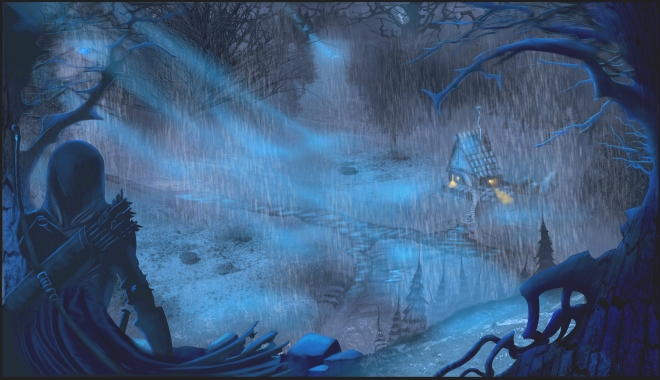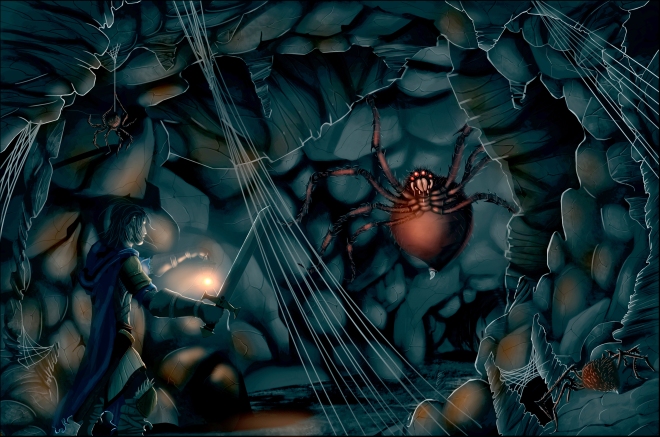There’s lots of questions, answers and advice (solicited or not) about what it takes to be a good DM. The DM’s role is a challenging one, no doubt. There is also occasionally some advice about being a good player, but probably not as much as there should be.
While the DM has a lot of responsibility in terms of managing the game framework, the players are just as responsible for ensuring the game runs smoothly and that it is comfortable and fun for everyone. More often than not, difficulties in an RPG group are caused by one or more players forgetting some of the more important aspects of the collaborative gaming experience.
What follows is by no means a comprehensive list, but touches on the critical aspects of being a ‘good’ player;

Guideline 1 – Fun is the most important thing.
RPG are games. It’s in the name. Fun is the most important thing. If you are having fun, great, skip the rest of this and move to Guideline 2.
If you aren’t having fun, or aren’t having as much fun as you could be, it’s worth examining why. Maybe the game style isn’t for you. Maybe the player group dynamic isn’t working. Maybe you are simply not in the right frame of mind for the game right now.
There can be any number of reasons for a lack of fun. Most can be overcome easily if you recognise what they are. If you can’t work out the issues within the group, it might be best looking for other options. There’s a whole world of games and gamers out there. You’re likely to find a good fit if you are willing to look. There’s nothing more damaging to a gaming group – and your overall enjoyment of RPGs – than persisting in a situation that isn’t right for you.
Guideline 2 – Your fun is as important as (not more or less than) everyone else’s
RPGs are – with a very few exceptions – group games with one DM (occasionally more) and 2 to 7 players (occasionally less or more). That means there are a number of people, all different, trying to enjoy the game. If the group dynamic is good, everyone should be working together and playing off of each other to create a shared experience as equals. Everyone has fun, and everyone leaves eagerly anticipating the next session.
But that’s not always the case. Sometimes imbalances are created when different styles or perspectives on how to play can clash. In an RPG group one of the most critical aspects is to understand that everyone should be equally represented, respected and involved. As a player you should be aware of not only ensuring your needs are met, but that the other players are getting theirs met too.
If you, or another player, are getting too much or too little opportunity to be active, there’s an imbalance. The DM will try to correct this, but you can help. Ask the other players what they want to do when situations arise where choices can be made. Actually listen to their ideas, especially if that’s ‘not the way you would do it’. Offer advice or opinions, but don’t try to tell other players how to play. Support and encourage other players. Celebrate their successes along with your own. Take your turn, but not more than your turn. By allowing equal opportunities for all players you’ll have more fun, they will have more fun, and everyone learns from each other.
Guideline 3 – RPGs are a team game
Following closely on from the above, RPGs are team games. This isn’t Counterstrike (a first person shooter for the uninitiated). Running off to do your own thing, lone wolf style is only going to cause problems on multiple levels. If you want to play alone, choose a different pastime. By sitting at the gaming table with a group of other people you are acknowledging that you are joining a team activity. Attempting to make it a singular activity is much like trying to pound a square peg into a round hole – it just doesn’t fit.
Team perspective starts at character creation. You might think a tomb robbing, undead raising necromancer is cool, but how will the rest of the group react when you start defiling corpses? What about an edgy anti-hero assassin who plays by his own rules? It makes for an interesting video game protagonist, but is that really going to work in an adventuring team? Your character concept is your own, but you also need to think about the setting and the other players, and whether or not it’s a good fit. Characters built to be self-contained without consideration for the rest of the group are called “Special Snowflakes” and no one (who isn’t playing one) really likes playing with those characters.
Similarly, when adventuring the premise of most RPGs is that the characters work together, providing various skills and strengths to the group to achieve goals. If your character wants to go it alone, try to star at every turn or activity, or is generally just unhelpful, it’s going to make the game tougher, and less enjoyable for everyone (including yourself). I know a player who constantly claims “I can’t play a rogue because I’d HAVE to steal from the party”. Setting aside his very myopic concept of a rogue, that kind of play is only going to upset people. Couching disruptive or selfish behaviours as “I’m only roleplaying my character, and it’s what they’d do” is the worst kind of justification. Think about it like this. Why would a group of characters that are in mortal danger from their occupation trust or accept another that doesn’t have their interests at heart? The players of those characters would be more than justified in kicking the Special Snowflake out of the group, and could honestly say that’s what their characters would do.
On the other hand, Characters designed and played to contribute to the team are not only going to make the party more effective, but they will be valued and enhance the game experience for everyone.

Guideline 4 – Be prepared, and be involved
As a player, turning up on time, bringing everything you need, and being interactive and involved is the icing on the cake. While it may not make or break a game, it is certainly noted, particularly if a player fails to do so repeatedly.
As a group activity, it takes co-ordination, effort and time to set up and continuously run a campaign. People are arranging their lives and responsibilities around finding fairly large blocks of time to play. Ensuring all the small details are attended to is really a mark of respect and courtesy to everyone involved and an acknowledgement that their time is as valuable as yours.
It goes doubly so for in-game activities. Paying attention and being interactive an involved when it’s not your turn speaks of respect, and ensures smooth play because you are following the changing conditions of the game around you. It also allows you to plan your next actions to ensure no time is wasted when your next turn comes up. Conversely playing on your phone or tablet, talking over or around DM exposition or other players or otherwise becoming distracted or disruptive practically screams “I don’t respect you and only care about my experience”.
Guideline 5 – You cannot ‘win’ and RPG and you shouldn’t try
An RPG adventure might have a beginning, series of events or action and a clear climax, but it never really ends. It’s not an adversarial game. It’s a collaborative storytelling experience. The true strength and value of an RPG lies in the journey itself, not the conclusion. It’s not a race to the end where you win the game. You cannot ‘win’ or ‘lose’ an RPG. You can advance, succeed, triumph, conquer or you can suffer setbacks, disaster, defeat or death. The differences are subtle, but important. All of these outcomes are emotive and open, whereas Win/Loss are final and closed.
When you play an RPG, you will get more satisfaction investing in the journey and tailoring your character and play style to that purpose. Having the ‘best’ toughest’ or ‘strongest’ character is far less important than having one with a rounded backstory, with character and personality, and with goals other than “kill all foes”.
If you are looking to win, RPGs aren’t your best choice. Videogames, board games, tabletop miniature war games or even magic-style card games cater for that. Trying to win an RPG will only result in frustration.
Guideline 6 – The DM is your friend and ally
A common mistake that make novice gamers make (and some veterans too) is that they perceive the DM as an adversary. It’s easy to do. They sit opposite you. They have a screen that further separates and isolates them. They control the adversaries of your character. They set challenges designed to test you. It certainly sounds like an opponent.
The truth is that the DM is your friend and ally. They are your biggest fan. They aren’t trying to kill your character (well some rare few might, but that is poor DMing and I’ll cover that elsewhere). Instead they are offering you the opportunities to interact, overcome and triumph. They provide you with a world to play in and NPCs to interact with. Sure they set adversaries that might kill you, but they also dispense rewards upon your statistically probable success.
If the DM wanted you to fail they could easily set insurmountable challenges. They don’t. They want you to succeed, and not only that, they spend hours upon hours preparing to offer you that opportunity.
At times when you are overcome by these challenges, or thwarted in your ‘genius’ or ‘foolproof’ plans, or a character dies it’s easy to begin to think of the DM as your enemy. You should reconsider that. Chances are they are taking it as hard as you. They are just as invested (and in some cases more invested) in the success of the game.

Guideline 7 – RPGs are for everyone
We are all – thankfully and gloriously – different. As people and as gamers. The great strength of this hobby is that it’s so accessible to everyone. All you need is an imagination, the desire to share the imaginative experience, and some odd shaped dice.
If you are lucky in your time as an RPG player you’ll meet hundreds if not thousands of other players and enjoy everything that diversity has to offer. Even if you don’t, you’re still likely to interact with some players that have a different perspective than you.
You are going to meet players who have different social, political or religious beliefs than you. You will meet players of different ages, genders, cultural backgrounds and lifestyles. You will meet people who have different views on RPGS – from ‘murderhobos’ (a term I really dislike), to min-maxers, to deep immersion roleplayers, LARPers and Cosplayers. You will not agree with or even like everyone you meet. That’s ok, so long as you afford everyone the basic respect and tolerance they deserve as people and fellow RPG enthusiasts. If you don’t feel comfortable around certain people or game styles that’s fine – find a better fit (see Guideline 1). Wheaton’s law applies here.
The RPG community makes our hobby possible, and the more inclusive and welcoming it is, the better off we all are. The more gamers we attract the more content is made, the more games are played, and the more likely it is you’ll find exactly what you are looking for.
And that rounds out my Guidelines for players. I’m sure there are many other pearls of wisdom out there for getting the most out of your experience, but these are the ones I find most useful as a starting point. Go forth and have fun.
Micah







 The group encountered some very wet and angry spiders the size of dogs, and infact these were only babies to a large arachnid that lay concealed in a size passage. While the threat of poison, fangs and was significant, the group found that sticks, fists, feet, giant hammers, arrows, fire breath and knives were to giant spiders as rolled up newspapers are to normal ones, and the arachnids were vanquished. The eagle-eyed Bree discerned an opportunity with some loose rocks suspended in the webbing, and Dart obliged in dropping them with a well timed arrow, ending the peril of ‘mummy’ spider.
The group encountered some very wet and angry spiders the size of dogs, and infact these were only babies to a large arachnid that lay concealed in a size passage. While the threat of poison, fangs and was significant, the group found that sticks, fists, feet, giant hammers, arrows, fire breath and knives were to giant spiders as rolled up newspapers are to normal ones, and the arachnids were vanquished. The eagle-eyed Bree discerned an opportunity with some loose rocks suspended in the webbing, and Dart obliged in dropping them with a well timed arrow, ending the peril of ‘mummy’ spider.
















